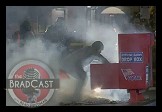READER COMMENTS ON
"NEW EXPLOSION AT JAPAN'S FUKUSHIMA DAIICHI UNIT NO. 3 NUKE REACTOR"
(48 Responses so far...)
COMMENT #1 [Permalink]
...
brian
said on 3/13/2011 @ 7:14 pm PT...
COMMENT #2 [Permalink]
...
TimFromLA
said on 3/13/2011 @ 7:48 pm PT...
My family lives in Fukushima. 50 miles away, but I still worry
COMMENT #3 [Permalink]
...
Suzan
said on 3/13/2011 @ 7:58 pm PT...
Thank you sir!
Hope it's okay to quote and link you at my site.
S
COMMENT #4 [Permalink]
...
stonemason89
said on 3/13/2011 @ 8:07 pm PT...
So what is hydrogen gas doing in a nuclear power plant? This isn't a fusion plant, is it?
COMMENT #5 [Permalink]
...
zapkitty
said on 3/13/2011 @ 8:15 pm PT...
... stonemason89 asked...
"So what is hydrogen gas doing in a nuclear power plant?"
The hydrogen was created by hite-hot zirconium cladding on the fuel rods reacting with water.
"This isn't a fusion plant, is it?"
er.... what the fuck?
1: There are no fusion power plants.
Our dear oligarch's work to see that it stays that way.
2: A fusion power plant can not ever have a meltdown or explode.
That's why we don't have them.
COMMENT #6 [Permalink]
...
zapkitty
said on 3/13/2011 @ 8:24 pm PT...
Wasn't intending to be rude in my last response, sorry.
It was just that the question was rather a non-sequitur in the middle of an ongoing and often heated discussion on that very subject that been going on here since the quake.
COMMENT #7 [Permalink]
...
TimFromLA
said on 3/13/2011 @ 8:45 pm PT...
Also Brad, here is Reactor 3 blowing up and you can see concrete falling from the sky
COMMENT #8 [Permalink]
...
DCP - Transatlantic Hip Hop
said on 3/13/2011 @ 8:45 pm PT...
This is an epic song just made march 11th after i watched the news of Japan. Its dedicated to everyone that lost their lives. WHY ARE THESE EARTHQUAKES HAPPENING? Also everyone please i would like to bring to your attention HAARP. if you dont know what it is by now. you may want to ask yourself why you dont. research it. and when you get a chance please listen to my song and give me some feedback. http://www.youtube.com/watch?v=wgQDnbnugdQ
COMMENT #9 [Permalink]
...
brian
said on 3/13/2011 @ 8:52 pm PT...
can Tim from LA tell jus what his family is aware of as they live right near by.
also:
FYI
One mayor in Fukushima Province isn't buying Tokyo's weak explanation and demanded the Nuclear and Industrial Safety Agency to conduct a serious all-points investigation immediately.
A specialist medical team from the National Radiology Health Institute, flown by helicopter from Chiba to a field center 5 km from the No.1 Nuclear Plant, found radiation illness in 3 residents out of a sample group of 90. Overnight that number of civilian-nuclear "hibakusha" shot up to 19, but in other counts to 160. The evacuation zone has been further widened from 10 km to 20 km.
A third reactor, Unit 6, has lost its cooling system and is overheating along with Reactors 1 and 2.
Fukushima No.2 plant, further south, is ringed by a wall of silence as a quiet evacuation is being conducted.
Firefighters are pumping seawater into the three overheated Fukushima 1 reactors. The mandatory freshwater supply is missing, presumably due to tsunami contamination from surging ocean waves. An American nuclear expert has called this desperation measure the equivalent of a "Hail Mary pass"..
So, the Prime Minister should be hoping that Japan's tiny Christian community is feverishly praying. Because right now, Japan and much of the world are living on a prayer.
http://en.m4.cn/archives/5789.html
COMMENT #10 [Permalink]
...
zapkitty
said on 3/13/2011 @ 9:14 pm PT...
"So, the Prime Minister should be hoping that Japan's tiny Christian community is feverishly praying. Because right now, Japan and much of the world are living on a prayer."
And the millions of Shinto, Buddhist and other prayers going out from Japan?
How parochial.
COMMENT #11 [Permalink]
...
Shena
said on 3/13/2011 @ 11:03 pm PT...
Heard that Reactor #3 is more dangerous than #1 because it is a MOX (Mixed oxide) reactor. It has a greater chance of melting down.
COMMENT #12 [Permalink]
...
Caroline Good
said on 3/14/2011 @ 12:20 am PT...
I hope nuclear and fossil fuel pushers are happy now. We tried to stop the Diablo Canyon in San Luis Obispo from being built so close to our San Andreas Fault in 1981. Protestors against it being built were arrested, 1,900 of them. There are now plans to built 12 more, after 20 years of no new plants. Let's stop the building of new plants and get the government to invest and develop renewable energy, of course we might have to do it while glowing.
COMMENT #13 [Permalink]
...
zapkitty
said on 3/14/2011 @ 12:22 am PT...
Where did you hear that?
Side note: need to clarify level of meltdown... the term is being used for melted and deformed fuel rods... which in itself is very bad news but is not the same as "melted through the bottom of the reactor" which is not the same as "melted through the basement of the building and is headed for Africa."
Mox is a mix of uranium and plutonium and the contamination from a containment breach would be worse than straight uranium... but what kind of breach? What kind of meltdown?
COMMENT #14 [Permalink]
...
Timo
said on 3/14/2011 @ 1:28 am PT...
frightening devellopments i think:
a) comparing the explosions there are major differences. the second explosion was much heavier and had more power released directly up. also the concrete falling down is not a good sign as maybe parts of the concrete directly above the reactor containment were damaged. close inspection (as far as you can see anything) of the still after explosion indicates more damage to the plant. not only the casing of the top level as in the 1st explosion
b) this could severely influence the maintainance and cooling of all other plants due to contamination and explosive force
c) at this rate, if no external power is restored we are looking at least at 3 meltdowns possibly rising to 6 (depending on how hot the last reactors are and how fast their protection can be ensured). with this develloment the 2nd block will most likely also explode...
d) looking at the limited contamination data i personally belive that high to very high doses were and will be set free. at the moment fortunately still without the problematic high half-live heavy elements. so we are seriously looking at major 100-200 year influences. the one hope we can have is that tokyo only receives "minor" doses.
e) this is MINIMUM an INES 6 incident
best luck and my sincere condolences to the people of japan
COMMENT #15 [Permalink]
...
Brad Friedman
said on 3/14/2011 @ 1:43 am PT...
Shena @ 13 said:
Heard that Reactor #3 is more dangerous than #1 because it is a MOX (Mixed oxide) reactor. It has a greater chance of melting down.
Having read the same thing yesterday, I looked into it with a nuclear engineer. See my "6:13pm" update & then "6:58pm" update for response to it from the nuke engineer in Saturday's live blog on the explosion at Unit 1.
In short, he poo-poos the report that the plutonium fuel is any worse than the uranium fuel (and notes also that the concerns about that seem to original emanate from anti-Nuke outfit, FWIW.)
COMMENT #16 [Permalink]
...
CarryTrader
said on 3/14/2011 @ 1:58 am PT...
The long term impact from the earthquake with depend on how the performance of the Yen. The repatriation of foreign assets by the Insurers to pay compensation will be an upward pressure on the Yen. The strength of the Japanese Yen will be the real danger to the Japanese economy.
Interestingly, the quick notes coming out of the desks are saying the European Insurers have the most exposure as a region to the Japanese quakes. Since they need to pay compensation, they need to liquidate assets. Assuming they are long their domestic bonds, it would increase the European yields. Another factor in the existing problems of the European sovereigns.
Carry Trader
Intrinsic Value
COMMENT #17 [Permalink]
...
brian
said on 3/14/2011 @ 2:26 am PT...
FYI did u know:
'PRC: In contrast to Washington's ulterior motives, China in an unprecedented move has sent in an emergency team into Japan. Unbeknownst to the world, China has world-leading expertise in extinguishing nuclear meltdowns and blocking radiation leaks at their uranium mines and military nuclear plants. This was discovered on a 2003 visit to a geological research center in the uranium-rich Altai mountain region of Xinjiang, where a scientist disclosed "off the record" China's development of mineral blends that block radiation "much more than 90 percent, nearly totally". When asked why the institute doesn't commercialize their formulas, he responded: "We've never thought about that." That's too bad because if one of China's exports was ever needed, it's their radiation blanket.
http://en.m4.cn/archives/5789.html
COMMENT #18 [Permalink]
...
Dredd
said on 3/14/2011 @ 5:50 am PT...
COMMENT #19 [Permalink]
...
UNF
said on 3/14/2011 @ 6:04 am PT...
So, the Prime Minister should be hoping that Japan's tiny Christian community is feverishly praying. Because right now, Japan and much of the world are living on a prayer.
Brad, you've let a Pat-Robertson-style xtian fundie nutter infiltrate the place ~ next we will be informed that the Tsunami etc., is Jehovah's belated revenge for allowing women the vote in 1919.
Here's my prayer: "Oh Dear Jeezis skrewed to a shingle, if you exist and could bother getting the proverbial finger out anytime in the near future, please cause your followers (and particularly the dumb yankee hypocrite variety thereof) to STFU until they have a clue and can lay off the evangelical god-bothering for ONE damned minute in their stupid lives. Amen!"
COMMENT #20 [Permalink]
...
Richard D. Masters
said on 3/14/2011 @ 6:47 am PT...
Hydrogen Explosion?
The vertical plume of the explosion at Reactor 3 appears to be shot from a cannon, with some very heavy elements falling out of the cloud. The shape of the dark cloud suggests that the top of the reactor vessel has ruptured. A bright red/orange flash can be seen at the moment of the explosion --- but hydrogen flame is invisible.
The hydrogen explosion at Reactor 1 blew the top and sides off the outer containment shell, hurling light dust and debris evenly away from the center. The shockwave propagation typical of hydrogen ignition events is not evident in the Reactor 2 explosion.
-- Richard D. Masters
International Clearinghouse for Hydrogen Commerce
hydrogencommerce.com
COMMENT #21 [Permalink]
...
Lora
said on 3/14/2011 @ 8:09 am PT...
As Greenpeace sez:
The earth is flat.
Pigs can fly.
Nuclear power is safe.
COMMENT #22 [Permalink]
...
zapkitty
said on 3/14/2011 @ 8:38 am PT...
... Lora said...
"As Greenpeace sez:
The earth is flat.
Pigs can fly.
Nuclear power is safe."
To be precise, the form of nuclear power allowed us lesser beings by our lords and masters has issues, especially when hit with the worst disaster locally in over a thousand years... and the plants in Japan are dated. Newer designs would have fared better. Simple fact.
And there are other forms of nuclear power both already prototyped and proposed that we are not permitted to use or research... and they would not have these issues even with a disaster of this magnitude.
Rail against the limits artificially imposed by our owners?
Certainly.
Rail against corporate greed that screws up with even the limited options that we are allowed?
Definitely.
Run screaming into the cold dark night at the mere mention of the word "nuclear?"
Then, unknowingly, you're dancing to the tune of the oligarchs... and unless you belong to the right groups you're not even getting reimbursed for your trouble.
COMMENT #23 [Permalink]
...
plunger
said on 3/14/2011 @ 9:13 am PT...
CNN is actively obfuscating and outright lying through its teeth re: meltdown. There is a full blown globalist media conspiracy to downplay the total nuclear disaster that has occurred. The spent fuel rods were stored in the upper level of the reactor building - WHICH IS GONE. Ask where 20 years worth of spent fuel rods went! These reactors have experienced total failure - and the radiation levels are in fact off the charts.
They are totally lying about everything.
Check out the comments section here:
http://bigdanblogger.blo...-news-march-12-2011.html
And for a recap of the Koch whores criminal behavior, be sure to catch Kudlow's show on CNBS tonight at 7:00
COMMENT #24 [Permalink]
...
plunger
said on 3/14/2011 @ 9:29 am PT...
ACTUAL EVIDENCE THAT CNN IS LYING:
Watch any current CNN news report (Monday afternoon).
Note that they are stating the following as a fact at present:
"radiation levels just outside the plant briefly rose above legal limits, but since had declined significantly."
That is a quote from an article published Sunday morning, which is likely also a lie:
http://www.theburningplatform.com/?p=12908
They are downplaying this (lying to you) on purpose - and they are doing it skillfully and intentionally.
Let this serve as the final conclusive proof that our "news" media - isn't. It is a propaganda mechanism - totally.
COMMENT #25 [Permalink]
...
zapkitty
said on 3/14/2011 @ 10:09 am PT...
Plunger, it would be nice to have details.
Verifiable ones wouldn't hurt.
It's perfectly possible that people are lying their collective asses off about a variety of things at the plants... but your links equate to a couple of pages of generic ranting with no way to sort details out.
COMMENT #26 [Permalink]
...
Roy Crenshaw
said on 3/14/2011 @ 10:46 am PT...
MAGNASCENT IODINE IS A GOOD PRODUCT.
COMMENT #27 [Permalink]
...
plunger
said on 3/14/2011 @ 10:50 am PT...
Zapkitty:
Why don't you call Obama and ask him to make public the live feed he is watching from the spy satellite parked directly over the blown reactors providing a perfect view of what remains? Does logic tell you that there is no containment on three blown nuclear reactors, or do you require someone with authority to confirm what your own eyes have seen?
Why in the world do you require me (or anyone) to provide you with details?
Have you done any research of your own into these reactor buildings? The links to Wikipedia were provided to you. Have you researched where these reactors store their spent fuel rods? Have you observed the tops of these buildings are blown off? Do you require hand holding to learn this for yourself?
When the top of a nuclear building is blown off, what do you deduce on your own?
COMMENT #28 [Permalink]
...
David Lasagna
said on 3/14/2011 @ 11:03 am PT...
To UNF @ comment 18 re:
Brad, you've let a Pat-Robertson-style xtian fundie nutter infiltrate the place
To Me this seems like an off the mark, hurried, misplaced projection on your part.
COMMENT #29 [Permalink]
...
Jeannie Dean
said on 3/14/2011 @ 11:09 am PT...
Our Gov / Media douche-canoes lying about air quality has remarkable, repeated, mountainous historical precedent.
I love your mind, Zap, but are you really asking for proof in linkage of that salient fact? Beyond the EPA telling us in 2001 the air in Lower Manhattan was perfectly safe to breath - as just one (comparatively minor) example - what more proof do you need?
COMMENT #30 [Permalink]
...
Ernest A. Canning
said on 3/14/2011 @ 11:24 am PT...
Amy Goodman reports that "Monday’s explosion, caused by a hydrogen buildup, blew the roof off a containment building at Fukushima Daiichi’s reactor."
According to Yurika Ayukawa, Professor of Climate, Energy, and Environment at Chiba University of Commerce in Japan, this has threatened a meltdown of reactor 2 at Fukushima 1, which makes "the third reactor that's going to be in a very critical situation."
COMMENT #31 [Permalink]
...
zapkitty
said on 3/14/2011 @ 11:28 am PT...
Obama's been off my speed dial since the FISA abomination.
However, you are aware, are you not, that the primary containment in this design is the reactor vessel itself?
You are aware, are you not, that there is no additional containment dome in the modern sense and that the building is a weather housing with the shell designed to blow out in the case of an explosion?
It is designed that way to avoid damaging the reactor vessel in the case of explosions such as those that are actually occurring.
As for the pools storing the spent rods, they are reinforced to hold tons of water and waste and...
... believe it or not...
... their structure can withstand a blast that blows out the outer building shell.
And lastly:
"pools are located above the reactor vessel"
does not equal
"pools are in the upper levels of a structure designed to blow outwards in the event of an explosion"
It's possible that bad things can happen to the pools and it's possible that bad things have happened to the pools and it's possible that bad things are happening to the pools at this very moment.
That's why it would be nice to have actual details instead of sound bites.
COMMENT #32 [Permalink]
...
plunger
said on 3/14/2011 @ 11:29 am PT...
The BBC reported LIVE on the afternoon of 9/11 that WTC7 had just collapsed, while it was in fact IN THE FRAME in the background behind the reporters head - only to fall some twenty minutes later. These reports out of Japan are no less absurd. You just saw the entire building explode, but are told to believe that the fuel rods remain well under control - while in other reports, members of the US Military have been exposed to radiation.
As if.
Don't wait for the "news" to tell you what your eyes have already seen - or what you can deduce to be true with your own magnificent mind.
Use it.
COMMENT #33 [Permalink]
...
mick
said on 3/14/2011 @ 11:53 am PT...
My son lives in Tokyo and the people there are "aware" of the Power Plants changing status but seem relaxed.
COMMENT #34 [Permalink]
...
plunger
said on 3/14/2011 @ 12:39 pm PT...
The big liars:
No indication of Japan nuclear reactor meltdown: IAEA
Updated at 1045 PST Monday, March 14, 2011
VIENNA: The UN atomic watchdog said Monday that it has no indication at the current time of a possible meltdown at the earthquake-hit nuclear reactors in Japan.
"We have no indication of fuel that is currently melting at this point," said James Lyons, director of the Safety at Nuclear Installations division at the International Atomic Energy Agency (IAEA).(AFP)
http://www.thenews.com.p...NewsDetail.aspx?ID=12604
Meanwhile - at the same time:
Japan's chief cabinet secretary Yukio Edano confirmed the fear of rods melting inside all three of the site's most troubled reactors.
"Although we cannot directly check it, it's highly likely happening," he said.
http://news.sky.com/skyn...plosion_At_Nuclear_Plant
Simply stated, there is no emergency protocol that includes pouring seawater into nuclear reactors - other than as a last resort. They are well beyond the point of control. This will not be contained. Where are the spent fuel rods stored on site? Why is no one discussing that?
COMMENT #35 [Permalink]
...
brian
said on 3/14/2011 @ 12:40 pm PT...
FYI
'From the beginning of the Great East Japan Earthquake, I have followed Japanese-language media closely, to see what they have to say about Japan's nuclear reactors. It is clear that the Japanese people were under a virtual information blockade, regarding the severity of the problems and their potential health consequences, due to the Japanese media's failure to challenge their government's lack of transparency and accountability. The possibility of a complete meltdown was frequently raised in international media from Day 1, but the Japanese media were silent on the worst case scenario at least for the first 24 hours.'
etc
http://mrzine.monthlyrev...011/furuhashi140311.html
COMMENT #36 [Permalink]
...
plunger
said on 3/14/2011 @ 12:57 pm PT...
Someone in India is talking about the spent fuel rods and GE's apparently faulty design for storage of them. Any surprise that GE is moot on the subject?
http://www.thehindu.com/...ional/article1537557.ece
Three Fukushima Daiichi reactors have suffered a loss-of-coolant accident and may yet undergo a partial or complete core meltdown with catastrophic consequences. There have been radioactivity releases of unspecified quantities from the reactors. Radioactivity from Fukushima has been detected 100 km away.
There is clinching evidence of reactor core/fuel damage from Reactor 1, which suffered two explosions, while Reactor 3 suffered one. The situation is yet to be brought under control despite desperate measures like pumping seawater into the reactors. There are fears that the spent fuel rods stored in the Reactor 1 building, in keeping with the General Electric design, pose a grave hazard because of the site flooding after the tsunami. These rods contain large quantities of high level radioactive waste, the statement said.
COMMENT #37 [Permalink]
...
plunger
said on 3/14/2011 @ 1:06 pm PT...
COMMENT #38 [Permalink]
...
plunger
said on 3/14/2011 @ 1:25 pm PT...
Here's the diagram of the building (note the height of the reactor and the space above the top of it):
http://www.denverpost.co...emRelationshipId=3641359
Here's a picture of what's left of the building:
http://www.denverpost.com/news/ci_17608440
And here's the description in the link above that speaks of where the 20 years worth of spent fuel rods USED TO BE:
Fears also mounted about the threat posed by the pools of water where years of spent fuel rods are stored.
At the 40-year-old Fukushima Daiichi Unit 1, where an explosion Saturday destroyed a building housing the reactor, the spent-fuel pool, in accordance with General Electric's design, is placed above the reactor. Tokyo Electric said it was trying to figure out how to maintain water levels in the pools, indicating that the normal safety systems there had failed too.
Failure to keep adequate water levels in a pool would lead to a catastrophic fire, said nuclear experts, some of whom think Unit 1's pool might now be outside.
"That would be like Chernobyl on steroids," said Arnie
Read more: Japanese nuclear plants fight failures - The Denver Post http://www.denverpost.co...i_17608440#ixzz1GbgoHDvH
Read The Denver Post's Terms of Use of its content: http://www.denverpost.com/termsofuse
Now - in light of these facts, is this not a picture of those spent fuel rods being launched and vaporized?
http://www.thiscantbehappening.net/node/509
Remember all the hubub and consternation over storage of spent fuel rods at Yucca Mountain in the United States and the extreme efforts and related debates surrounding this issue?
http://www.google.com/im...mp;biw=1290&bih=1017
GE's design to store them on site has just been proven disastrous. Don't expect NBC to tell you how, or why. Don't expect Obama's man, Immelt, to say anything about it either.
This is how fascism, combined with propaganda, work.
COMMENT #39 [Permalink]
...
plunger
said on 3/14/2011 @ 1:41 pm PT...
"As Robert Alvarez, a former nuclear energy adviser to President Bill Clinton, has written, if these waste containers, euphemistically called “ponds,” were to be damaged in an explosion and lose their cooling and radiation-shielding water, they could burst into flame from the resulting burning of the highly flammable zirconium cladding of the fuel rods, blasting perhaps three to nine times as much of these materials into the air as was released by the Chernobyl reactor disaster. (And that’s if just one reactor blows!) Each pool, Alvarez says, generally contains five to ten times as much nuclear material as the reactors themselves."
http://www.commondreams.org/view/2011/03/13-6
So, I ask each of you point blank, have we not already experienced multiple Chernobyls with these explosions and the blasting of spent fuel rods and highly radioactive water from these "ponds" into the atmosphere? What does your own mind tell you? What did you see in these explosions? Do you need to hear it confirmed by "experts" or "politicians?"
Why are you not seeing this story on CNN? What caused a "radioactive cloud?"
US aircraft carrier reportedly sails into radioactive cloud
http://www.jpost.com/Int...l/Article.aspx?id=212057
COMMENT #40 [Permalink]
...
Lora
said on 3/14/2011 @ 2:00 pm PT...
Zapkitty wrote,
Run screaming into the cold dark night at the mere mention of the word "nuclear?"
Then, unknowingly, you're dancing to the tune of the oligarchs... and unless you belong to the right groups you're not even getting reimbursed for your trouble.
Indeed I don't run screaming. I was once a scientist (once a scientist always a scientist?) and used the "nuclear power" of radioactive isotopes in many experiments (and experienced a spill which caused me to have to collect my urine for 24 hours to see if it glowed in the dark!
(Well...really to see if it registered on the scintillation counter at all. It didn't, over background, anyway.)
But, I stand by Greenpeace's quote. Nuclear power, such as we have at this time in this country or in this world, is simply NOT safe in any way. Whether it ever can be MADE safe is debatable, and somehow I think I'd take government assurances of nuclear energy safety about as much as I would take assurances of safety of deep ocean oil well rigs, or natural gas fracking, or any of that sort of stuff.
And the trouble is, once radiation is leaked into the world, it ain't going away for a very, very, very long time.
Background radiation is higher than it used to be. Think about that. I, for one, do not want to let any more of that type of genie out of the bottle. This is one that really can't be put back in once it's out.
COMMENT #41 [Permalink]
...
plunger
said on 3/14/2011 @ 2:17 pm PT...
The boiling-water reactors at Fukushima — 40 years old and designed by General Electric — have spent fuel pools several stories above ground adjacent to the top of the reactor. The hydrogen explosion may have blown off the roof covering the pool, as it's not under containment. The pool requires water circulation to remove decay heat. If this doesn't happen, the water will evaporate and possibly boil off. If a pool wall or support is compromised, then drainage is a concern. Once the water drops to around 5-6 feet above the assemblies, dose rates could be life-threatening near the reactor building. If significant drainage occurs, after several hours the zirconium cladding around the irradiated uranium could ignite.
Then all bets are off.
On average, spent fuel ponds hold five-to-ten times more long-lived radioactivity than a reactor core. Particularly worrisome is the large amount of cesium-137 in fuel ponds, which contain anywhere from 20 to 50 million curies of this dangerous radioactive isotope. With a half-life of 30 years, cesium-137 gives off highly penetrating radiation and is absorbed in the food chain as if it were potassium.
In comparison, the 1986 Chernobyl accident released about 40 percent of the reactor core’s 6 million curies. A 1997 report for the Nuclear Regulatory Commission (NRC) by Brookhaven National Laboratory also found that a severe pool fire could render about 188 square miles uninhabitable, cause as many as 28,000 cancer fatalities, and cost $59 billion in damage. A single spent fuel pond holds more cesium-137 than was deposited by all atmospheric nuclear weapons tests in the Northern Hemisphere combined.
http://www.commondreams.org/view/2011/03/13-6
If the recent blasts emitted the highly radioactive water and spent fuel rods into the atmosphere, all of this hand-wringing about whether or not the reactor units melt down is moot. The damage is already done - with the remnants strewn into the ocean and air.
What is the ACTUAL exposure level for ALL sailors aboard the USS Ronald Reagan? What role will Jeffrey Immelt play from here forward relative to this exposure, likely caused by GE's plant design - which failed to account for the venting of hydrogen gas from the building AND stored the spent fuel rods atop a nuclear bomb?
Did a US company, whose CEO (Immelt) is a top adviser to the President of the United States, just doom the crew of the flagship of the Republican party, the USS Ronald Reagan, via exposure to a radioactive cloud equal to "multiple Chernobyls?"
God, I hope not, but this crew will let us know the truth soon enough.
COMMENT #42 [Permalink]
...
karenfromillinois
said on 3/14/2011 @ 2:50 pm PT...
COMMENT #43 [Permalink]
...
plunger
said on 3/14/2011 @ 2:53 pm PT...
Reactor #3 is a MOX-fueled reactor. See how much that matters (and why they're not talking about it) right here:
http://sherriequestionin...lear-plant-uses-mox.html
I assume they stored those spent MOX fuel rods atop the reactor. You'll never learn the truth in the MSM - so don't wait to educate yourself.
COMMENT #44 [Permalink]
...
plunger
said on 3/14/2011 @ 3:10 pm PT...
Guardian article reveals known design flaws and spent fuel rod issue:
http://www.guardian.co.u...r/14/nuclearpower-energy
There is growing concern about the status of irradiated fuel pools at all of the Fukushima reactors. The pools are located inside the outer containment building above the core and, like the reactor cores, require constant cooling. Pictures from the site show that at least the top third of two containment buildings have been blown off, so the integrity of the fuel pools is unclear.
COMMENT #45 [Permalink]
...
plunger
said on 3/14/2011 @ 3:28 pm PT...
3,450 old fuel assemblies were in the #3 Reactor building as of 2101 (how many of these were MOX?).
The threat of a fission explosion at the Fukushima power facility emerged today when the roof of the number three reactor exploded and fears that a spent fuel pool, located over the reactor, has been compromised. The pool, designed to allow reactor fuel to cool off for several years, was constructed on top of the Fukushima reactors instead of underground. As of 2010, there were 3450 fuel assemblies in the pool at the number three reactor. The destruction of the number three reactor building has experts concerned about whether the spent fuel storage pool, which sits just below the roof, could have survived intact the hydrogen explosion. The explosion was much more severe than Saturday’s blast at the number one reactor.
As massive amounts of seawater are pumped by fire trucks into Fukushima’s failing nuclear reactors and cooling ponds, the radioactive waste water, now laden with a variety of radioisotopes, is being flushed into the sea.
Just how much danger the spent fuel pool raises is made clear in a November 2010 powerpoint presentation from the Tokyo Electric Company detailing how fuel storage works at the huge complex.
The fuel inventory in the pool is detailed on page 9. According to TEPCO, each reactor generates 700 "waste" fuel assemblies a year, and there are 3450 assemblies in each pool at the Fukushima Daiichi plant, plus another 6,291 in a common pool in a separate building.
As shown in slide 10, the common pool building sits at ground level, with the pool itself above ground. The building also has windows on at least one side, and experts fear these were broken out by the tsunami which would have flooded the building.
According to Albert Donnay, a former nuclear engineer, “This means the common pool is now full of radioactive and corrosive seawater that will cause the fuel assemblies to fail and burst open, as they are doing inside the reactor cores that have been deliberately flooded with seawater. If the pool drains or boils away, the fuel will melt, burn and even possibly explode if the fuel collapses into a sufficiently critical mass.”
This may explain why the Japanese government began adding boric acid to the reactor spent fuel pools at the facility shortly after the earthquake and tidal wave.
http://www.dcbureau.org/...losion-at-fukushima.html
Yup, it's THAT BAD.
COMMENT #46 [Permalink]
...
Harry
said on 3/14/2011 @ 11:07 pm PT...
Recovery should be back soon…Sorry for the victims of the disaster…
COMMENT #47 [Permalink]
...
Gaxon
said on 3/15/2011 @ 3:40 am PT...
This is a horrifying disaster, but despite this, the people of Japan are truly resilient.
COMMENT #48 [Permalink]
...
California Repossession Attorney
said on 3/15/2011 @ 10:08 am PT...
Prayer be with the families in Japan

 Yesterday, the emergency cooling system at Unit 3 had failed, prompting officials to announce another "nuclear emergency" following the earthquake and tsunami that occurred in Japan one day earlier. Officials had taken the unusual measure to cool the reactor with sea water, which means it's unlikely to be usable ever again.
Yesterday, the emergency cooling system at Unit 3 had failed, prompting officials to announce another "nuclear emergency" following the earthquake and tsunami that occurred in Japan one day earlier. Officials had taken the unusual measure to cool the reactor with sea water, which means it's unlikely to be usable ever again.





 Former Federal Prosecutor: Trump Must Be Sentenced in NY Before Taking Office Again: 'BradCast' 11/20/24
Former Federal Prosecutor: Trump Must Be Sentenced in NY Before Taking Office Again: 'BradCast' 11/20/24 'Bullet Ballot' Claims, Other Arguments for Hand-Counting 2024 Battleground Votes: 'BradCast' 11/19/24
'Bullet Ballot' Claims, Other Arguments for Hand-Counting 2024 Battleground Votes: 'BradCast' 11/19/24 'Green News Report' 11/19/24
'Green News Report' 11/19/24
 Trump Already Violating Law (He Signed!) During Transition: 'BradCast' 11/18/24
Trump Already Violating Law (He Signed!) During Transition: 'BradCast' 11/18/24 Sunday 'Into the Gaetz of Hell' Toons
Sunday 'Into the Gaetz of Hell' Toons Computer Security Experts Ask Harris to Seek Hand-Counts Due to Voting System Breaches: 'BradCast' 11/14/24
Computer Security Experts Ask Harris to Seek Hand-Counts Due to Voting System Breaches: 'BradCast' 11/14/24  'Green News Report' 11/14/24
'Green News Report' 11/14/24 Trump Criminal Cases Fade After Election as GOP 'Does Not Believe in Rule of Law': 'BradCast' 11/13/24
Trump Criminal Cases Fade After Election as GOP 'Does Not Believe in Rule of Law': 'BradCast' 11/13/24 Climate Advocates Brace for Fight With Trump 2.0: 'BradCast' 11/12/24
Climate Advocates Brace for Fight With Trump 2.0: 'BradCast' 11/12/24 'Green News Report' 11/12/24
'Green News Report' 11/12/24 Let It All Out: 'BradCast' 11/11/24
Let It All Out: 'BradCast' 11/11/24 Sunday 'Like it or Not' Toons
Sunday 'Like it or Not' Toons Not All Bad: Abortion Rights Won Big (Almost) Everywhere: 'BradCast' 11/7/24
Not All Bad: Abortion Rights Won Big (Almost) Everywhere: 'BradCast' 11/7/24 'Green News Report' 11/7/24
'Green News Report' 11/7/24 U.S. CHOOSES CONVICTED CRIMINAL, ADJUDICATED RAPIST: 'BradCast' 11/6/24
U.S. CHOOSES CONVICTED CRIMINAL, ADJUDICATED RAPIST: 'BradCast' 11/6/24 ELECTION DAY 2024: Tea Leaves, Probs for Voters, What's Next: 'BradCast' 11/5/24
ELECTION DAY 2024: Tea Leaves, Probs for Voters, What's Next: 'BradCast' 11/5/24 'Closing Arguments' for Undecideds, Third-Party Voters: 'BradCast' 11/4/24
'Closing Arguments' for Undecideds, Third-Party Voters: 'BradCast' 11/4/24 The GOP 'Voter Fraud' Before the Storm: 'BradCast' 10/31/24
The GOP 'Voter Fraud' Before the Storm: 'BradCast' 10/31/24 'Closing Arguments'with Digby and Driftglass: 'BradCast' 10/30/24
'Closing Arguments'with Digby and Driftglass: 'BradCast' 10/30/24 Trump Promises to be a Lawless, Authoritarian President. Believe Him: 'BradCast' 10/29/24
Trump Promises to be a Lawless, Authoritarian President. Believe Him: 'BradCast' 10/29/24 Ballots Burn, Billion-aires 'Obey in Advance', Callers Ring In: 'BradCast' 10/28/24
Ballots Burn, Billion-aires 'Obey in Advance', Callers Ring In: 'BradCast' 10/28/24 Musk's Privatized Internet Satellite System Threatens U.S. National Security
Musk's Privatized Internet Satellite System Threatens U.S. National Security
 VA GOP VOTER REG FRAUDSTER OFF HOOK
VA GOP VOTER REG FRAUDSTER OFF HOOK Criminal GOP Voter Registration Fraud Probe Expanding in VA
Criminal GOP Voter Registration Fraud Probe Expanding in VA DOJ PROBE SOUGHT AFTER VA ARREST
DOJ PROBE SOUGHT AFTER VA ARREST Arrest in VA: GOP Voter Reg Scandal Widens
Arrest in VA: GOP Voter Reg Scandal Widens ALL TOGETHER: ROVE, SPROUL, KOCHS, RNC
ALL TOGETHER: ROVE, SPROUL, KOCHS, RNC LATimes: RNC's 'Fired' Sproul Working for Repubs in 'as Many as 30 States'
LATimes: RNC's 'Fired' Sproul Working for Repubs in 'as Many as 30 States' 'Fired' Sproul Group 'Cloned', Still Working for Republicans in At Least 10 States
'Fired' Sproul Group 'Cloned', Still Working for Republicans in At Least 10 States FINALLY: FOX ON GOP REG FRAUD SCANDAL
FINALLY: FOX ON GOP REG FRAUD SCANDAL COLORADO FOLLOWS FLORIDA WITH GOP CRIMINAL INVESTIGATION
COLORADO FOLLOWS FLORIDA WITH GOP CRIMINAL INVESTIGATION CRIMINAL PROBE LAUNCHED INTO GOP VOTER REGISTRATION FRAUD SCANDAL IN FL
CRIMINAL PROBE LAUNCHED INTO GOP VOTER REGISTRATION FRAUD SCANDAL IN FL Brad Breaks PA Photo ID & GOP Registration Fraud Scandal News on Hartmann TV
Brad Breaks PA Photo ID & GOP Registration Fraud Scandal News on Hartmann TV  CAUGHT ON TAPE: COORDINATED NATIONWIDE GOP VOTER REG SCAM
CAUGHT ON TAPE: COORDINATED NATIONWIDE GOP VOTER REG SCAM CRIMINAL ELECTION FRAUD COMPLAINT FILED AGAINST GOP 'FRAUD' FIRM
CRIMINAL ELECTION FRAUD COMPLAINT FILED AGAINST GOP 'FRAUD' FIRM RICK SCOTT GETS ROLLED IN GOP REGISTRATION FRAUD SCANDAL
RICK SCOTT GETS ROLLED IN GOP REGISTRATION FRAUD SCANDAL VIDEO: Brad Breaks GOP Reg Fraud Scandal on Hartmann TV
VIDEO: Brad Breaks GOP Reg Fraud Scandal on Hartmann TV RNC FIRES NATIONAL VOTER REGISTRATION FIRM FOR FRAUD
RNC FIRES NATIONAL VOTER REGISTRATION FIRM FOR FRAUD EXCLUSIVE: Intvw w/ FL Official Who First Discovered GOP Reg Fraud
EXCLUSIVE: Intvw w/ FL Official Who First Discovered GOP Reg Fraud GOP REGISTRATION FRAUD FOUND IN FL
GOP REGISTRATION FRAUD FOUND IN FL


































